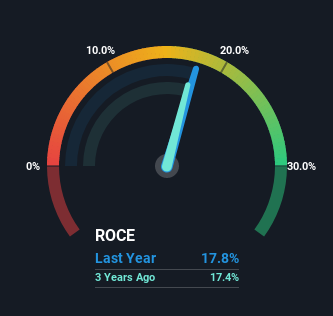
What trends should we look for it we want to identify stocks that can multiply in value over the long term? Typically, we'll want to notice a trend of growing return on capital employed (ROCE) and alongside that, an expanding base of capital employed. Ultimately, this demonstrates that it's a business that is reinvesting profits at increasing rates of return. So, when we ran our eye over De'Longhi's (BIT:DLG) trend of ROCE, we liked what we saw.
What is Return On Capital Employed (ROCE)?
For those who don't know, ROCE is a measure of a company's yearly pre-tax profit (its return), relative to the capital employed in the business. The formula for this calculation on De'Longhi is:
Return on Capital Employed = Earnings Before Interest and Tax (EBIT) ÷ (Total Assets - Current Liabilities)
0.18 = €421m ÷ (€3.8b - €1.4b) (Based on the trailing twelve months to December 2021).
Therefore, De'Longhi has an ROCE of 18%. In absolute terms, that's a satisfactory return, but compared to the Consumer Durables industry average of 13% it's much better.
Check out our latest analysis for De'Longhi

Above you can see how the current ROCE for De'Longhi compares to its prior returns on capital, but there's only so much you can tell from the past. If you'd like, you can check out the forecasts from the analysts covering De'Longhi here for free.
What Does the ROCE Trend For De'Longhi Tell Us?
While the current returns on capital are decent, they haven't changed much. The company has consistently earned 18% for the last five years, and the capital employed within the business has risen 96% in that time. 18% is a pretty standard return, and it provides some comfort knowing that De'Longhi has consistently earned this amount. Stable returns in this ballpark can be unexciting, but if they can be maintained over the long run, they often provide nice rewards to shareholders.
In Conclusion...
To sum it up, De'Longhi has simply been reinvesting capital steadily, at those decent rates of return. And given the stock has only risen 2.5% over the last five years, we'd suspect the market is beginning to recognize these trends. So to determine if De'Longhi is a multi-bagger going forward, we'd suggest digging deeper into the company's other fundamentals.
If you want to know some of the risks facing De'Longhi we've found 3 warning signs (1 is significant!) that you should be aware of before investing here.
While De'Longhi isn't earning the highest return, check out this free list of companies that are earning high returns on equity with solid balance sheets.
New: Manage All Your Stock Portfolios in One Place
We've created the ultimate portfolio companion for stock investors, and it's free.
• Connect an unlimited number of Portfolios and see your total in one currency
• Be alerted to new Warning Signs or Risks via email or mobile
• Track the Fair Value of your stocks
Have feedback on this article? Concerned about the content? Get in touch with us directly. Alternatively, email editorial-team (at) simplywallst.com.
This article by Simply Wall St is general in nature. We provide commentary based on historical data and analyst forecasts only using an unbiased methodology and our articles are not intended to be financial advice. It does not constitute a recommendation to buy or sell any stock, and does not take account of your objectives, or your financial situation. We aim to bring you long-term focused analysis driven by fundamental data. Note that our analysis may not factor in the latest price-sensitive company announcements or qualitative material. Simply Wall St has no position in any stocks mentioned.
About BIT:DLG
De'Longhi
Produces and distributes coffee machines, food preparation and cooking machines, air conditioning and heating, domestic cleaning and ironing, and home care products.
Flawless balance sheet with solid track record and pays a dividend.
Similar Companies
Market Insights
Community Narratives



